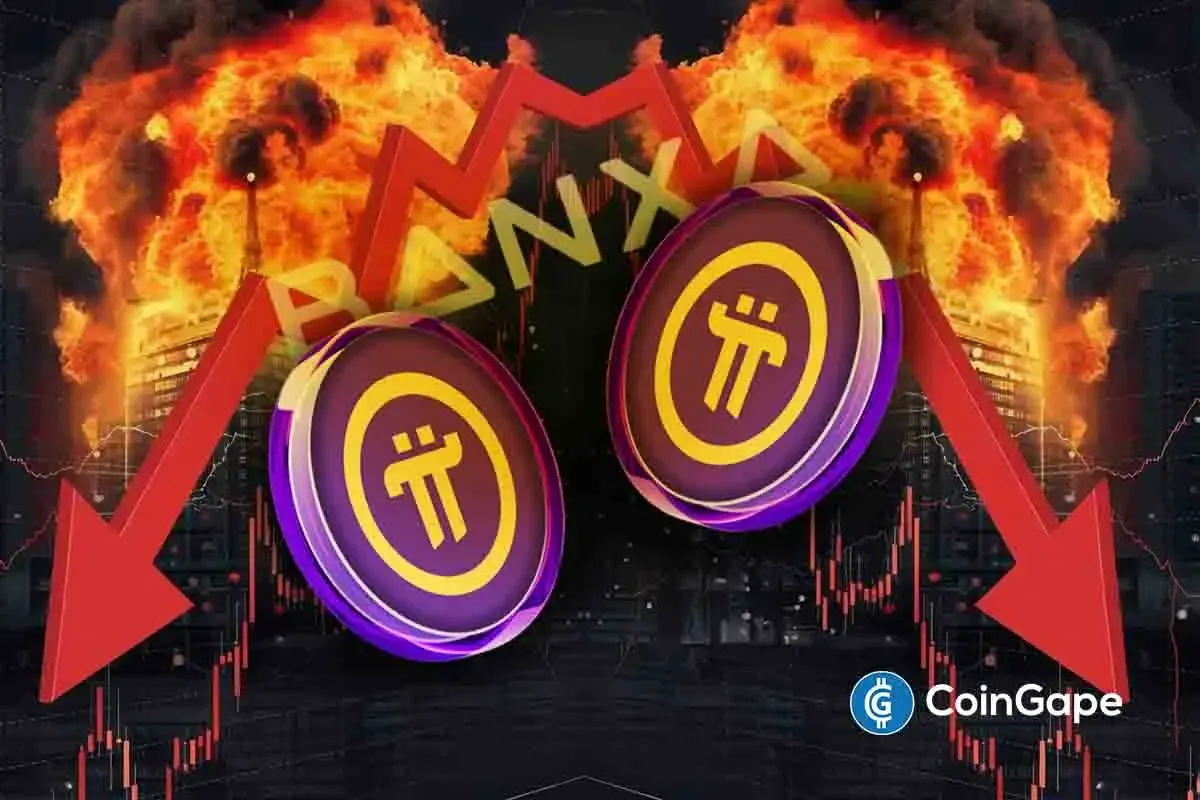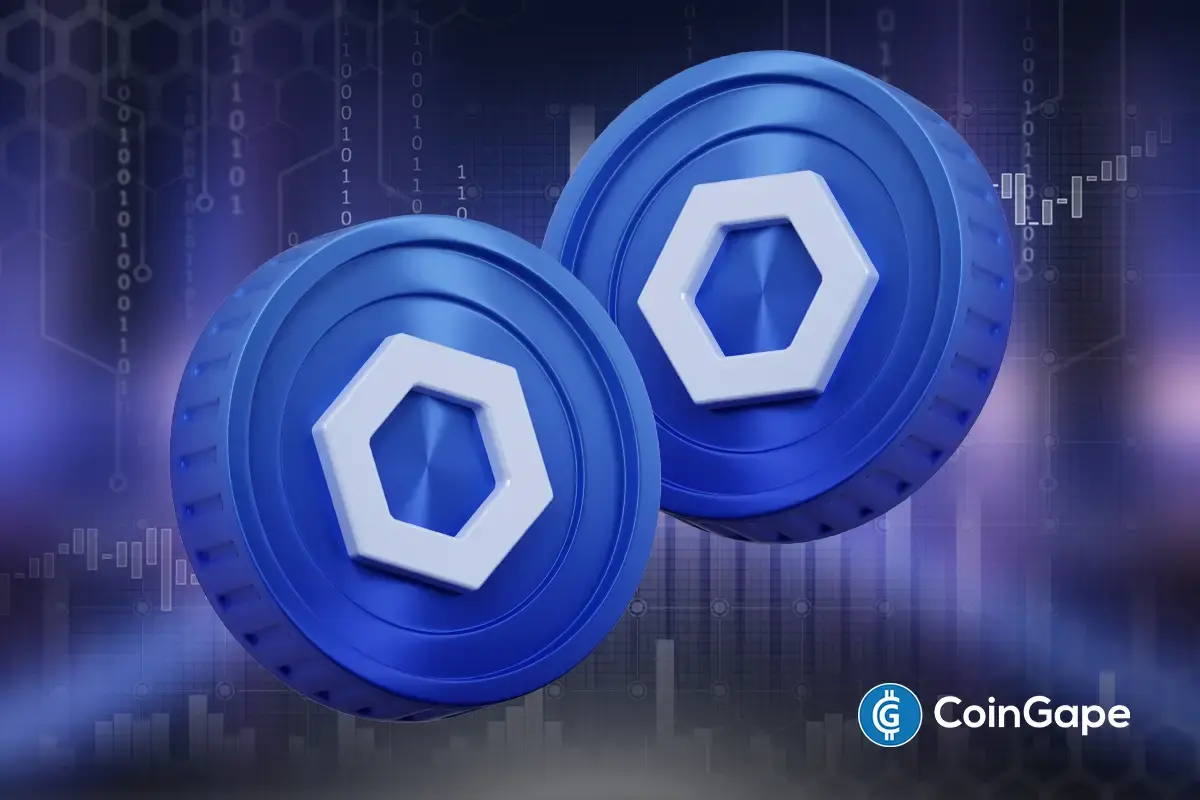Ethereum
Ethereum Open Interest Sees Fastest Rise In 5 Months: Brace For More Volatility?
Keshav is currently a senior writer at NewsBTC and has been attached to the website since June 14, 2021.
Keshav has been writing for many years, first as a hobbyist and later as a freelancer. He has experience working in a variety of niches, even fiction at one point, but the cryptocurrency industry has been the longest he has been attached to.
In terms of official educational qualifications, Keshav holds a bachelor’s degree in Physics from one of the premier institutes of India, the University of Delhi (DU). He started the degree with an aim of eventually making a career in Physics, but the onset of COVID led to a shift in plans. The virus meant that the college classes had to be delivered in the online-mode and with it came free time for him to explore other passions.
Initially only seeking to make some beer money, Keshav unexpectedly landed clients offering real projects, after which there was no looking back. Writing was something he had always enjoyed and to be able to do it for a living was like a dream come true.
Keshav completed his Physics degree in 2022 and has been focusing on his writing career since, but that doesn’t mean his passion for Physics has ended. He eventually plans to re-enter university to obtain a masters degree in the same field, but perhaps only to satiate his own interest rather than for using it as a means to find employment..
Keshav has found blockchain and its concepts fascinating ever since he started going down the rabbit-hole back in 2020. On-chain analysis in particular has been something he likes to research more about, which is why his NewsBTC pieces tend to involve it in some form.
Being of the science background, Keshav likes if concepts are clear and consistent, so he generally explains the indicators he talks about in a bit of detail so that the readers can perhaps come out having understood and learnt something new.
As for hobbies, Keshav is super into football, anime, and videogames. He enjoys football not only as a watcher, but also as a player. For games, Keshav generally tends towards enjoying singleplayer adventures, with EA FC (formerly FIFA) being the only online game he is active in. Though, perhaps due to being ultra-focused on the game, he is today a semi-pro on the EA FC scene, regularly participating in tournaments and sometimes even taking back prize money.
Because of his enthusiasm for anime and games, he also self-learned Japanese along the way to consume some of the untranslated gems out there. The skill didn’t merely remain as just a hobby, either, as he put it to productive use during his exploration for small-time gigs at the start of COVID, fulfilling a couple of Japanese-to-English translation jobs.
Keshav is also big into fitness, with agility and acceleration-related workouts making a big part of his program due to the relevance they have in football. On top of that, he also has a more traditional strength based program for the gym, which he does to maintain an overall fitness level of his body.
Ethereum
Ethereum Price Stalls In Tight Range – Big Price Move Incoming?

Reason to trust

Strict editorial policy that focuses on accuracy, relevance, and impartiality
Created by industry experts and meticulously reviewed
The highest standards in reporting and publishing
Strict editorial policy that focuses on accuracy, relevance, and impartiality
Morbi pretium leo et nisl aliquam mollis. Quisque arcu lorem, ultricies quis pellentesque nec, ullamcorper eu odio.
Ethereum is trading at critical levels after enduring weeks of aggressive selling pressure. Since retracing below the key $2,000 mark, the second-largest cryptocurrency has struggled to regain bullish momentum. Currently down 21% from that level, ETH continues to hover near $1,580, reflecting a clear lack of conviction from both buyers and sellers.
Related Reading
The market has entered a period of extreme indecision. According to top analyst Daan, Ethereum’s price has remained notably compressed, barely moving over the past two days. This type of consolidation often precedes sharp price action in either direction, and traders are watching closely for signs of a breakout or breakdown.
Macroeconomic uncertainty continues to influence investor sentiment, with global trade tensions and monetary policy concerns keeping pressure on risk assets like Ethereum. For now, bulls must reclaim the $1,850 resistance zone to confirm a trend reversal, while a drop below $1,500 could open the door to deeper losses.
As volatility builds in the background, the current compression could be the calm before a storm—setting the stage for Ethereum’s next decisive move. Will it break out to the upside, or is more downside in store?
Ethereum Compression Signals Breakout As Macro Pressure Builds
Ethereum is facing a critical test as it trades at compressed levels following weeks of sustained selling pressure. The broader crypto market remains under pressure as global tensions escalate. US President Donald Trump’s trade war with China continues to shape macroeconomic sentiment, leaving investors cautious across all high-risk asset classes.
Despite last week’s announcement of a 90-day tariff pause for all countries except China, uncertainty remains. The unresolved status of US-China trade relations continues to weigh on markets and is one of the primary factors driving hesitation in price movement. For Ethereum, this has translated into extremely low volatility and a stalled price structure.
Daan shared insights suggesting that Ethereum’s price has been “extremely compressed” and has not shown meaningful movement for the better part of two days. According to Daan, this type of compression usually precedes a significant breakout—though the direction of that move remains unknown.
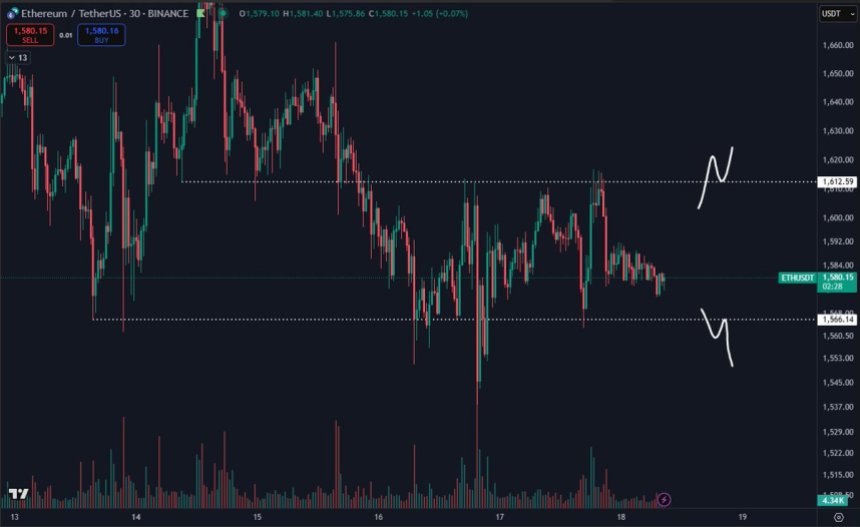
Investors and traders alike are closely monitoring this setup, as compressed price action typically leads to large, momentum-driven shifts. With broader macro risks still in play, Ethereum’s next move could define the short-term trend and set the tone for the market in the weeks ahead.
Related Reading
ETH Bulls Aim To Regain Control
Ethereum is trading at $1,590 after several days of sideways price action, hovering between support at $1,550 and resistance near $1,700. Despite holding above the lower end of this range, ETH has struggled to generate the momentum needed to break out and confirm a short-term recovery.
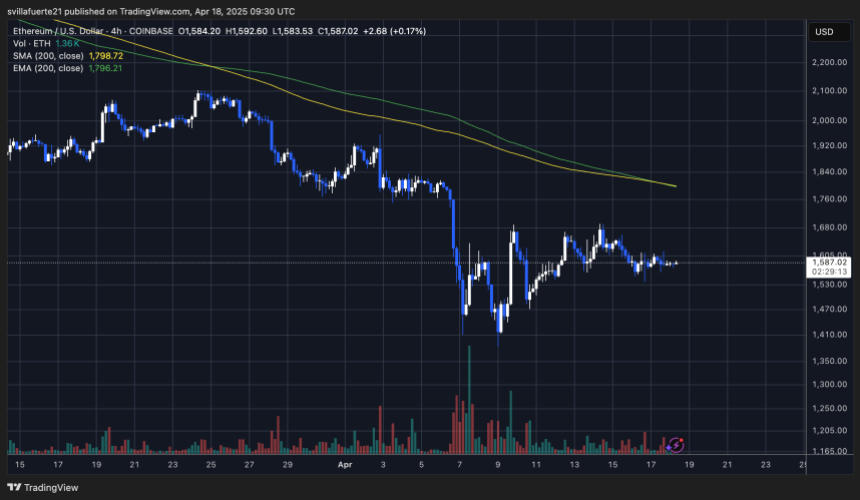
For bulls to establish a stronger position, ETH must push above the 4-hour 200-day moving average (MA) and exponential moving average (EMA), both of which continue to act as dynamic resistance. A breakout above these indicators could trigger renewed interest from traders and signal the beginning of a recovery phase.
However, the true test lies at the $2,000 level—a major psychological and technical resistance zone. Reclaiming this level would mark a shift in market sentiment and open the door to higher targets.
Related Reading
On the downside, failure to gain ground above the current range and a drop below $1,550 could quickly drag ETH below $1,500, increasing the risk of a deeper correction. For now, Ethereum remains in a consolidation phase, and the next decisive move will likely dictate whether bulls regain control or if sellers push prices into lower demand zones.
Featured image from Dall-E, chart from TradingView
Ethereum
Ethereum Fee Plunges To 5-Year Low—Is This A Bottom Signal?


On-chain data shows the Ethereum transaction fee has dropped to the lowest level in years recently. Here’s what this could mean for ETH’s price.
Ethereum Average Fees Now Valued At Just $0.168
In a new Insight post, the on-chain analytics firm Santiment has discussed the latest trend in the Average Fees of Ethereum. The “Average Fees” is a metric that, as its name suggests, keeps track of the average amount of fees that senders on the ETH network are attaching with their transactions.
This indicator’s value directly correlates to the amount of traffic that the blockchain is dealing with. The reason behind this lies in the fact that the network only has a limited capacity to handle transfers.
When the chain is busy, transfers can remain stuck in waiting until the transactions ahead of them clear out. Those who want their transactions to be processed ASAP can choose to attach a larger-than-average fee, so that the validators prioritise them.
In times of especially high traffic, this kind of competition among users can quickly drive the Average Fees up to significant levels. When there is little activity, however, senders have little incentive to pay any notable amount of fees, so the metric’s value can remain low.
It would appear that Ethereum has been witnessing the latter kind of conditions recently, as the Average Fees have registered a drop.
Looks like the value of the metric has declined to a low level in recent days | Source: Santiment
As displayed in the above graph, the Ethereum Average Fees have fallen to a low of $0.168 recently, which is the lowest that it has been since 2020. This means that activity on the network is historically low at the moment.
According to the analytics firm, this may not actually be so bad from a trading perspective, as low fee periods can often precede rebounds in the cryptocurrency’s price.
Below is a chart that shows an example of this trend in action:

The past trend in the transaction fees of ETH | Source: Santiment
As is visible in the above graph, the Ethereum Average Fees falling under the $1 mark back in 2023 led to bullish momentum for the asset. The explanation behind this pattern may lie in the fact that low-fee periods can indicate disinterest from the crowd.
Historically, ETH and other digital assets have tended to move in a way that goes contrary to the expectation of the majority. This means that a lack of optimism can lead to rebounds, while excessive hype can result in tops. From the chart, it’s apparent that ETH’s Q1 2024 top came as the metric surpassed $15, indicating a plethora of excitement.
“Generally, fee levels under $1 are a pretty promising sign that the crowd has become disinterested,” notes the analytics firm. “Just remember that there is no set guaranteed “bottom” or “top” level every time fee costs breach below or above a certain level.”
ETH Price
At the time of writing, Ethereum is trading around $1,600, up more than 1% in the last 24 hours.
Looks like the price of the asset hasn't moved much recently | Source: ETHUSDT on TradingView
Featured image from Dall-E, Santiment.net, chart from TradingView.com

Editorial Process for bitcoinist is centered on delivering thoroughly researched, accurate, and unbiased content. We uphold strict sourcing standards, and each page undergoes diligent review by our team of top technology experts and seasoned editors. This process ensures the integrity, relevance, and value of our content for our readers.
Ethereum
Ethereum Investors Suffer More Losses Than Bitcoin Amid Ongoing Market Turmoil
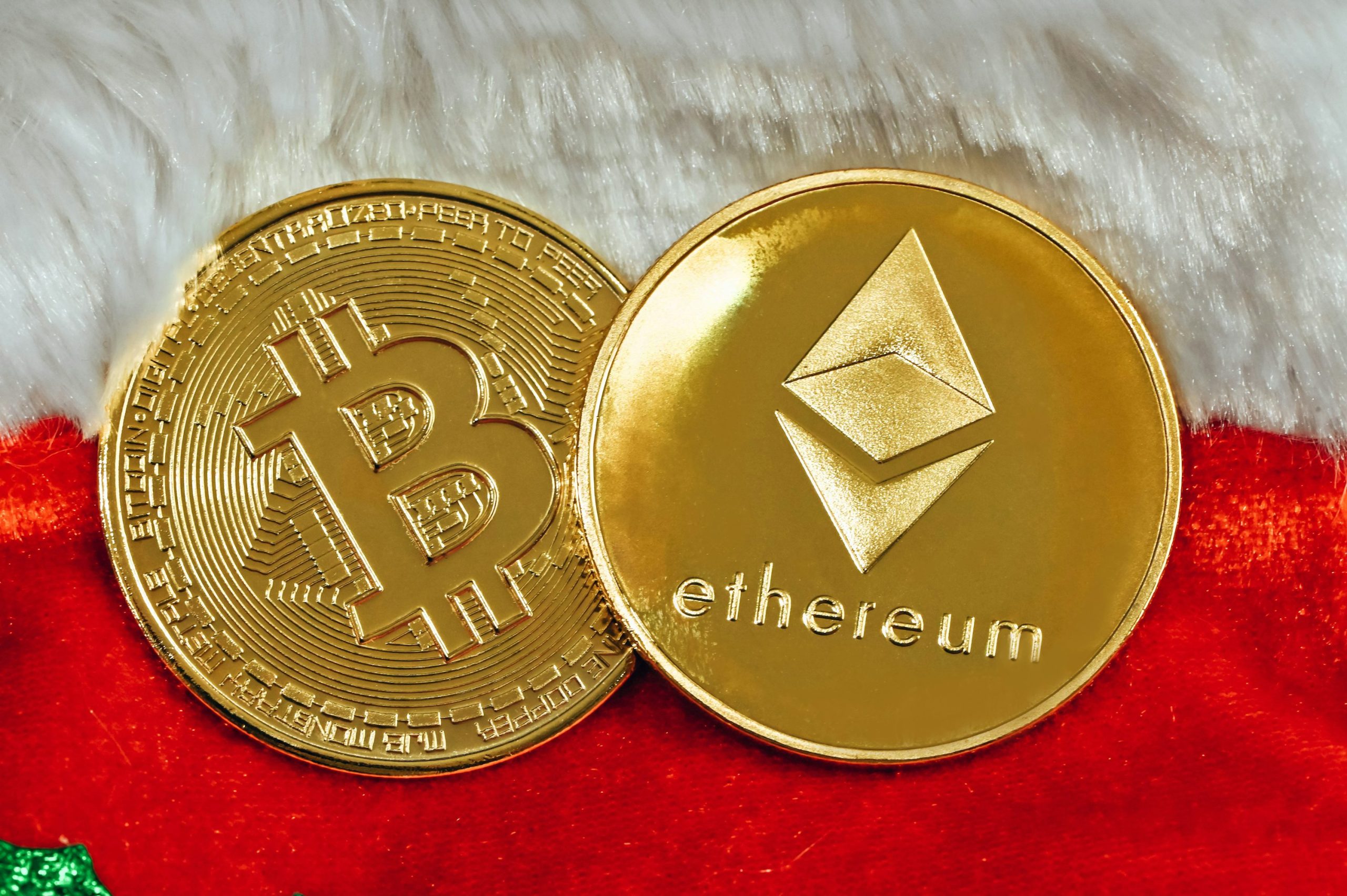

Given the continued volatility in the general crypto market, several major digital assets such as Ethereum and Bitcoin experienced a decrease in investor participation. As a result, the two crypto giants were faced with significant selling pressure, with ETH recording more losses than Bitcoin.
Ethereum Outpaces Bitcoin In Recent Losses
Over the last few days, Ethereum and Bitcoin have struggled with notable bearish pressure that has hampered their upward movements. During this volatile period, seasoned market expert and host of the Crypto Banter show, Kyle Doops, has outlined substantial losses in both assets as observed in the 6-Hour Rolling Losses metric.
Ethereum’s value has declined more precipitously than that of several of its competitors, triggering selling pressure among investors. During the recent sell-off, Ethereum holders have locked in $564 million in losses, highlighting growing investor caution and a shift in market sentiment.
According to the expert, this is one of the worst losses ETH investors have experienced since the 2023 bull began. The notable losses raise concerns about ETH’s short-term resilience and future performance as volatile market conditions constantly affect investors’ confidence in the altcoin.
Kyle Doops highlighted that while losses are decreasing, this could imply that the market is adjusting to lower pricing. With the market adapting to lower price conditions, the market expert is confident that capitulation is still present.

In another X post, Kyle Doops reported that Bitcoin is navigating rough waters as it suffers significant losses amid persistent market turbulence. This huge loss has also triggered speculations about the sustainability of BTC’s renewed upward trend to key levels like $85,000.
Data from the expert reveals that investors of the largest cryptocurrency asset experienced about $250 million in realized losses in just 6 hours after last week’s sharp drop. In the current market cycle, this loss is one of the biggest so far.
However, looking at the chart, each leg down is exhibiting less pain, which suggests that sellers might be running out of ammo. As key technical resistance levels continue to hinder BTC’s uptrend, the future of the flagship asset is becoming increasingly uncertain.
Where One Of ETH’s Strongest Support Lies
ETH has made a brief rebound to the $1,600 mark after a sudden drop on Wednesday. Delving into the price action, Ali Martinez, a crypto analyst, has underlined a crucial support zone for Ethereum, where significant investor interest was seen in spite of continued price fluctuation.
While the altcoin slowly rebounds, Ali Martinez highlighted that the $1,528.50 is a key support level in its price dynamics. This is due to the notable accumulation around this level. On-chain data shows that about 2.61 million wallet addresses purchased more than 4.82 million ETH in this zone, making it a robust area of support against downside pressure.
Featured image from Unsplash, chart from Tradingview.com

Editorial Process for bitcoinist is centered on delivering thoroughly researched, accurate, and unbiased content. We uphold strict sourcing standards, and each page undergoes diligent review by our team of top technology experts and seasoned editors. This process ensures the integrity, relevance, and value of our content for our readers.
-
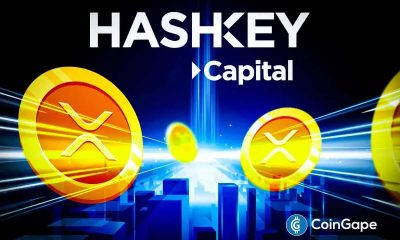
 Altcoin24 hours ago
Altcoin24 hours agoHashKey Launches First XRP Tracker Fund With Ripple’s Backing
-

 Market23 hours ago
Market23 hours agoBitcoin Price Gears Up for Next Leg Higher—Upside Potential Builds
-

 Altcoin18 hours ago
Altcoin18 hours agoEthereum ETFs Record $32M Weekly Outflow; ETH Price Crash To $1.1K Imminent?
-

 Market10 hours ago
Market10 hours agoPi Network Roadmap Frustrates Users Over Missing Timeline
-

 Market9 hours ago
Market9 hours agoSolana (SOL) Price Rises 13% But Fails to Break $136 Resistance
-

 Market21 hours ago
Market21 hours ago100 Million Tokens Could Trigger Decline
-
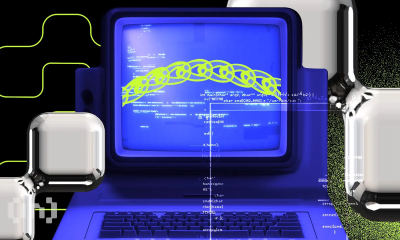
 Market19 hours ago
Market19 hours agoWhy Relying on TVL Could Mislead Your DeFi Strategy
-

 Market18 hours ago
Market18 hours agoCZ’s Plan to Streamline BNB Staking Could Boost DeFi










